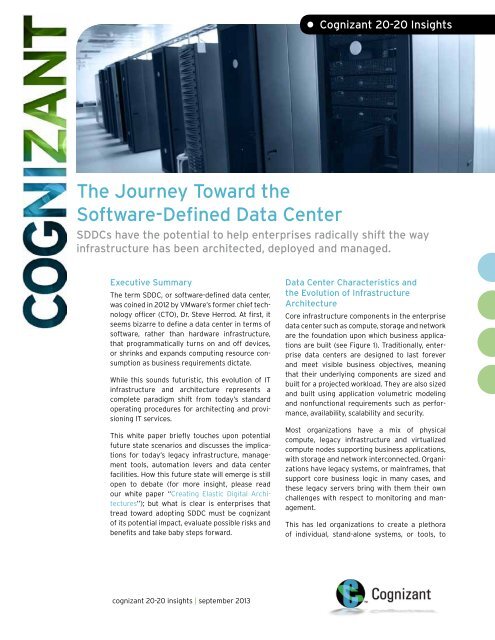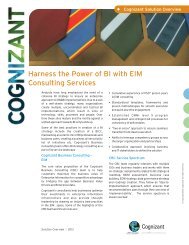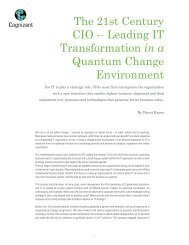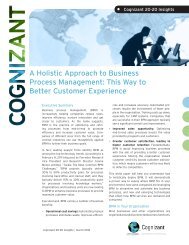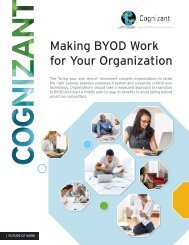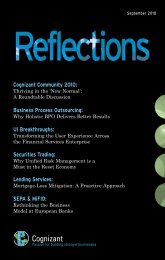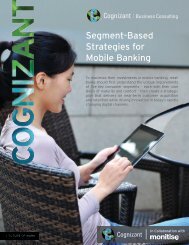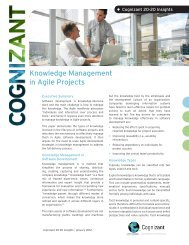The Journey Toward the Software-Defined Data Center - Cognizant
The Journey Toward the Software-Defined Data Center - Cognizant
The Journey Toward the Software-Defined Data Center - Cognizant
Create successful ePaper yourself
Turn your PDF publications into a flip-book with our unique Google optimized e-Paper software.
• <strong>Cognizant</strong> 20-20 Insights<strong>The</strong> <strong>Journey</strong> <strong>Toward</strong> <strong>the</strong><strong>Software</strong>-<strong>Defined</strong> <strong>Data</strong> <strong>Center</strong>SDDCs have <strong>the</strong> potential to help enterprises radically shift <strong>the</strong> wayinfrastructure has been architected, deployed and managed.Executive Summary<strong>The</strong> term SDDC, or software-defined data center,was coined in 2012 by VMware’s former chief technologyofficer (CTO), Dr. Steve Herrod. At first, itseems bizarre to define a data center in terms ofsoftware, ra<strong>the</strong>r than hardware infrastructure,that programmatically turns on and off devices,or shrinks and expands computing resource consumptionas business requirements dictate.While this sounds futuristic, this evolution of ITinfrastructure and architecture represents acomplete paradigm shift from today’s standardoperating procedures for architecting and provisioningIT services.This white paper briefly touches upon potentialfuture state scenarios and discusses <strong>the</strong> implicationsfor today’s legacy infrastructure, managementtools, automation levers and data centerfacilities. How this future state will emerge is stillopen to debate (for more insight, please readour white paper “Creating Elastic Digital Architectures”);but what is clear is enterprises thattread toward adopting SDDC must be cognizantof its potential impact, evaluate possible risks andbenefits and take baby steps forward.<strong>Data</strong> <strong>Center</strong> Characteristics and<strong>the</strong> Evolution of InfrastructureArchitectureCore infrastructure components in <strong>the</strong> enterprisedata center such as compute, storage and networkare <strong>the</strong> foundation upon which business applicationsare built (see Figure 1). Traditionally, enterprisedata centers are designed to last foreverand meet visible business objectives, meaningthat <strong>the</strong>ir underlying components are sized andbuilt for a projected workload. <strong>The</strong>y are also sizedand built using application volumetric modelingand nonfunctional requirements such as performance,availability, scalability and security.Most organizations have a mix of physicalcompute, legacy infrastructure and virtualizedcompute nodes supporting business applications,with storage and network interconnected. Organizationshave legacy systems, or mainframes, thatsupport core business logic in many cases, and<strong>the</strong>se legacy servers bring with <strong>the</strong>m <strong>the</strong>ir ownchallenges with respect to monitoring and management.This has led organizations to create a plethoraof individual, stand-alone systems, or tools, tocognizant 20-20 insights | september 2013
Standard <strong>Data</strong> <strong>Center</strong> AttributesDesigned to LastHeterogeneousCompute FlavorsSilo ManagementToolsMix Physical andVirtual ComputeLegacy ComputeMultitude of StoragePlatformsNetworkedto FunctionFigure 1perform monitoring and management functionsacross server farms. Moreover, many use aseparate set of tools for managing network andstorage performance. This results in enterprisedata centers that lack a single, unified view ofresource availability across infrastructure, to <strong>the</strong>application and database layers.<strong>The</strong> infrastructure is designed and provisionedconsidering <strong>the</strong> specific volumetric for supporting<strong>the</strong> business applications and considering <strong>the</strong>peak load transaction in jobs per second, availabilityand scalability requirements. When volumetricand projected growth do not manifest asenvisaged, this method of sizing infrastructurecompute and storage could lead to ei<strong>the</strong>r undersizingor oversizing <strong>the</strong> footprint. Often, havingsuch islands of infrastructure compute andstorage leads to underutilization of resources.This has a cascading effect on investment and<strong>the</strong> effort expended toward energy consumption,management overheads, software licenses anddata center costs.<strong>The</strong> shortcomings of this model led many enterprisesto <strong>the</strong> next wave of infrastructure design— utilizing shared infrastructure services andvirtualized compute to increase efficiency inresource utilization and ensure that infrastructureis designed and fit for <strong>the</strong> purpose, and notover-engineered. Figure 2 depicts how a sharedinfrastructure delivery design is leveraged, consideringguidelines such as grouping of applicationswith similar workload and grouping ofline-of-business applications, with virtualizedcompute resources. In this model, applicationsreap <strong>the</strong> benefit of virtualization, with hypervisorsenabled to programmatically allocate and deallocatecompute resources for applications. <strong>The</strong>bare metal hardware controlled by <strong>the</strong> hypervisorsoftware can be fur<strong>the</strong>r partitioned and guestoperating systems with logically separate instancescan be instantiated, resulting in increased utilization.This model has its advantages in terms of howresources are efficiently utilized in ideal applicationworkloads. However, when one or more applicationworkloads begin to consume more resourcesthan expected, scenarios could arise whereseveral guest operating systems are short ofcompute resources, <strong>the</strong>reby impacting businessapplication service level agreements.While this approach brought holistic capacitymanagement, monitoring and tools capabilities,it also provided evidence that infrastructurecompute and server resources were truly benefitingfrom improved resource utilization andautomation. This was brought about, to a certainextent, by programmatically controlling <strong>the</strong>resources provided to guest instances. However,new thinking about solutions was still needed tomeet <strong>the</strong> challenges of dynamic workloads of run<strong>the</strong>-businessapplications and compute-intensiveenterprise applications.With <strong>the</strong> emergence of <strong>the</strong> cloud, <strong>the</strong> new age“mantra” and infrastructure as a service (IaaS) asa delivery model (as illustrated in Figure 3), <strong>the</strong>challenges of processing demands from dynamicworkloads is being addressed. Designing highavailabilityclusters and scalable solutions can bearchitected based on nonfunctional requirements.cognizant 20-20 insights2
IT Infrastructure: Shared Resource ModelGuest OS/VM withApplication WorkloadsAbstraction Layer for ComputeHypervisorBare MetalFigure 2Since it is elastic by nature, <strong>the</strong> cloud deliverymodel enables resources to expand or shrinkbased on consumption. An abstraction softwarelayer, known as hypervisor, virtualizes processingresources from <strong>the</strong> bare metal, <strong>the</strong>reby enablingcompute, memory and hard disks to accommodateflexing demand.<strong>Software</strong>-defined server virtualization is ableto efficiently and dynamically allocate sharedpooledresources to balance workloads, <strong>the</strong>rebymeeting application requirements. Through automation,self-service, orchestration and meteringability, <strong>the</strong> success of enterprise server virtualizationhas prompted IT organizations to extend thiscapability across <strong>the</strong> data center, with softwarecontrolling <strong>the</strong> hardware. What follows are <strong>the</strong>steps that key industry sectors must take andways enterprises can approach and overcome <strong>the</strong>perceived challenges that will emerge.<strong>Software</strong>-defined server virtualization has thusbecome mainstream. Our experience reveals thatnumerous organizations have implemented or arein <strong>the</strong> process of implementing technologies tohelp <strong>the</strong>m get <strong>the</strong>re. With this model, we can saythat compute bottleneck at <strong>the</strong> server hardwarelayer is more or less eliminated. However, unlessplanned and executed, this hardware resourceconstraint shifts to <strong>the</strong> storage I/O and networkI/O. This, in turn, brings an equally challengingproblem of ensuring <strong>the</strong> abstraction at <strong>the</strong>storage and network layers is tightly coupled with<strong>the</strong> server abstraction layer.In <strong>the</strong> next sections, we examine if this is permissibleand how <strong>the</strong> industry is helping to perpetuatesoftware-defined infrastructure and programmatically-controlledhardware to create moreelastic IT resources.Dynamic Infrastructure Compute SchemaSelf-Service PortalsOrganization VDCsCatalogsMeteringAutomationManagement StackAbstraction LayerFigure 3cognizant 20-20 insights3
<strong>The</strong> Solution: A Vision of FutureState <strong>Data</strong> <strong>Center</strong>s<strong>The</strong> software-defined data center can be definedas using software to control <strong>the</strong> bare metal (orhardware), with an ability to turn services on andoff, <strong>the</strong>reby shrinking or expanding resources tomeet a defined level of service assurance. <strong>The</strong>mechanisms to achieve this lie in <strong>the</strong> ability toabstract <strong>the</strong> hardware layer and provide computeservices as virtual resources to <strong>the</strong> applicationsseeking <strong>the</strong>m through <strong>the</strong> following options:• Server virtualization.• Storage virtualization or software-definedstorage.• Network virtualization or software-definednetworking.As discussed in <strong>the</strong> previous section, server virtualizationenabled via hypervisor as <strong>the</strong> abstractionlayer has reached mainstream adoption. <strong>The</strong>re isongoing R&D to bring storage and network devicesto equivalent maturity. A multitude of nicheproducts already exist in this area; moreover,numerous acquisitions by large original equipmentmanufacturers (OEMs) are adding SDDCcapabilities to <strong>the</strong>ir hardware products. However,<strong>the</strong> vendor community<strong>The</strong> future stateof <strong>the</strong> data centerencompasses hardwareinfrastructure designedand programmaticallycontrolled by softwareacross server, storageand network.lacks a comprehensiveframework to allow organizationsto deploy andminimize <strong>the</strong> risk of beingearly SDDC adopters. Inaddition, available solutionsstill lack <strong>the</strong> ability todemonstrate how existinginfrastructure or legacyinfrastructure could beleveraged and convergedwith SDDC infrastructure.One promising development is <strong>the</strong> OpenDayLightProject where a set of companies have defineda common goal of establishing an open-sourceframework for software-defined networking(SDN).Across server, storage and network, regardlessof <strong>the</strong>ir maturity, organizations can now quicklydraw <strong>the</strong> mapping on abstraction layers for <strong>the</strong>irhardware devices. Figure 4 documents withan asterisk (*) that technologies are emergingaround SDN.As with o<strong>the</strong>r virtual technologies, network virtualizationprovides an abstraction layer on variousphysical network devices, <strong>the</strong>reby retaining <strong>the</strong>network’s physical properties, such as packetforwarding and trustworthy packet routing, butenabling logical isolation and device independence.Some experts define network virtualizationas a network that can be instantiated,operated and removed without physical networkasset interaction by <strong>the</strong> network administrator.<strong>Software</strong>-defined networking can be leveraged toenable virtualized networks, <strong>the</strong>reby decoupling<strong>the</strong> data and <strong>the</strong> network hardware.With storage virtualization, physical storagedevices are pooled and used as virtual resources.<strong>The</strong> future state of <strong>the</strong> data center encompasseshardware infrastructure designed and programmaticallycontrolled by software across server,storage and network. <strong>The</strong> converged infrastructurewithin this future state must have an ability tointegrate with existing legacy systems in <strong>the</strong> datacenter. Power and cooling solutions, for instance,need <strong>the</strong> intelligence to switch on and off basedon consumption. An all-encompassing dashboardis also required to indicate <strong>the</strong> health of variouscomponents within <strong>the</strong> SDDC. Hardware managementand monitoring, coupled with software,needs intelligence to automate tasks and selfheal/self-learnproblems.Conceptual View of <strong>the</strong> SolutionSDDCs are an extension to <strong>the</strong> cloud deliverymodel of infrastructure as a service (IaaS), andbasic tenets of cloud delivery model will exist asfoundational building blocks. Additional integrationlayers between legacy hardware, data centerfacilities and an all-encompassing monitoringand management stack are among <strong>the</strong> o<strong>the</strong>r keytenets to this solution.SDN EmergesServerStorageNetworkFigure 4HW TierAbstraction LayerHypervisorLUN/Volumes/Virtual DisksEvolving* (VMware NSX) is one such, OpenFlow protocolcognizant 20-20 insights 4
Today’s <strong>Data</strong> <strong>Center</strong> Infrastructure Architecture: A Conceptual ViewLimited Functionality of Service PortalsSecurity LayerApplicationOperating SystemVirtual Machine HardwareOptimize RAM, vCPU, Storage, Resource Limits & ReservationsHypervisorResource Pools, HA, <strong>Data</strong> Stores, Parameter TuningPhysical HardwareServer, Storage, NetworkAutomation and Management LayerCatalogFigure 5Figure 5 depicts a conceptual view of today’s infrastructurearchitecture in a traditional data center.<strong>The</strong> surrounding data center components suchas data center facilities and legacy infrastructurewould exist in <strong>the</strong> estate, as individual componentsin <strong>the</strong> data center. Figure 6 illustrates <strong>the</strong>infrastructure architecture surrounding SDDC,where software programmatically controls, andis deployed to meet, enterprise business applicationsfor dynamic workloads.SDDC blocks need to be holistic for integrationacross physical, legacy and data center facilities.This requires third-party vendors with plug-ins toprovide <strong>the</strong> interfaces.• Physical hardware and legacy infrastructure:This constitutes <strong>the</strong> bare metal hardwareand data centers that can be virtualized acrossphysical or legacy systems. <strong>The</strong> ability of <strong>the</strong>seto be involved and controlled via software, programmatically,will be based on <strong>the</strong> evolutionof technology or business needs, dependingon <strong>the</strong> abstraction of server, storage, networkcomponents and legacy integration requirements.OEMs and converged infrastructurevendors are key players since <strong>the</strong>y design,fabricate and integrate to make this happen.• Management layer: This consists of an integratedsuite of management and monitoringInfrastructure Surrounding SDDC: A Conceptual ViewConsumption of Services and Self-Service Design PortalsApplicationSecurity LayerOperating SystemVirtual Machine HardwareOptimize RAM, vCPU, Storage, Virtual Network Ports,Resource Limits & Reservations<strong>Software</strong>-<strong>Defined</strong> Services of Server, Storage and Network, Converged FabricHypervisorVirtual Resource Pools, HA, <strong>Data</strong> Stores, Parameter TuningPhysical HardwareServer, Storage, NetworkLegacy InfraCatalogGateway InterfaceModule<strong>Data</strong><strong>Center</strong>FacilitiesAutomation and Management LayerThird Party PluginsFigure 6cognizant 20-20 insights 5
solutions for <strong>the</strong> data center estate, comprisingoperations and performance engineeringcapabilities.• Gateway interface module: For SDDCs tobe mainstream, <strong>the</strong>y must be integratedwith existing data center components. Thisgateway module will comprise multi-vendorOEM plug-ins connecting with <strong>the</strong> existing datacenter footprint. OEM partners and servicesystem integrators need to drive this.• <strong>Data</strong> center facilities: Considering that <strong>the</strong>reis an increase in dynamic resource shifts,enhanced power and cooling components areneeded to drive control and provision requirementsthat meet <strong>the</strong> scale and demands of<strong>the</strong> data center effectively. Plug-ins and applicationprogramming interfaces (APIs) mustalso be scaled up and tightly coupled with <strong>the</strong>converged infrastructure.• Consumption and service design: <strong>The</strong> abilityto consume hardware, controlled via software,will materialize through a customized servicepartner’s portal, as well as OEM players’integrated solutions.Future SDDC: A Logical View<strong>Software</strong>- Controlled SecurityFigure 7Legacy HWManagement Stations<strong>Software</strong>- Designed<strong>Data</strong> <strong>Center</strong>Converged <strong>Data</strong><strong>Center</strong> Fabric<strong>Software</strong>-<strong>Defined</strong>Virtual Compute<strong>Software</strong>-<strong>Defined</strong> DCF<strong>Software</strong>-<strong>Defined</strong>Virtual Storage<strong>Software</strong>-<strong>Defined</strong>Virtual PortsAs we see from <strong>the</strong>se key tenets of <strong>the</strong> infrastructurearchitecture, a very strong integrationacross multi-vendor components is required.With minimal common standard reference frameworkand guidelines, SDDC reference architecturewill continue to evolve in <strong>the</strong> next five to 10years. Figure 7 shows a logical depiction of SDDCto visually explain <strong>the</strong> challenges we foresee inmainstream adoption.Power and CoolingAs noted above, power and cooling play animportant role in making <strong>the</strong> SDDC vision real.Moreover, a common standard approved referencearchitecture is needed to convert visioninto reality. Given <strong>the</strong> current state of enterprisearchitecture, a unified fabric including power,cooling, SAN fabric, IP for LAN and storage blocklevel data through fiber is still more of a visionthan a reality.For a data center, <strong>the</strong> facilities play an importantrole in ensuring that <strong>the</strong> SLAs are alignedand met. Given <strong>the</strong> mix of data center categoriesin use (such as tier 1, 2, 3 or 4, with tier 4 datacenters built for maximum resiliency and uptime),data center providers must develop integratedand adaptable power and cooling solutions in linewith <strong>the</strong> infrastructure capacity planned and provisioned.With <strong>the</strong> software-defined abstraction layer,<strong>the</strong>oretically numerous virtual machines can bedeployed. However, VM sprawl can be disastrousgiven that <strong>the</strong>re can be only finite amount ofpower and cooling. To bring <strong>the</strong>se SDDCs in to<strong>the</strong> mainstream, <strong>the</strong> data center must optimizepower usage. <strong>The</strong>refore, providers must redefinekey integration touch points of <strong>the</strong> data center,and build management systems, infrastructuremanagement and monitoring systems.<strong>The</strong> potential of software-defined power can bereached if <strong>the</strong> industry reaches a consensus on asolution with reference architecture and commonstandards. This will help to provide power to datacenters based on demand consumption, ra<strong>the</strong>rthan planning and provisioning <strong>the</strong> power andcooling requirements based on preexisting knowledgeof peak systems usage.Management and MonitoringSDDC will result in <strong>the</strong> entire data center infrastructurebeing controlled via software, programmaticallyturning on and off devices and controlling<strong>the</strong> behavior of individual systems. Considermission-critical applications that leverage suchan infrastructure and in <strong>the</strong> event of an incidentrequiring troubleshooting, <strong>the</strong> holistic view is ofutmost importance; i.e., proper management andmonitoring of <strong>the</strong> data center footprint, alongcognizant 20-20 insights 6
with <strong>the</strong> ability to quickly identify, diagnose, correlate,isolate and resolve issues. <strong>The</strong> existingmanagement and monitoring stack for <strong>the</strong> siloedcomponents will not be effective and responsiveenough to be able to help diagnose issues pertainingto <strong>the</strong> foundational elements of <strong>the</strong> stack,and can result in excessive lead times for problemresolution. <strong>The</strong> change will be driven by softwarethat will work at an enormous speed to keep trackof individual siloed components.Management of <strong>the</strong> stack will be from <strong>the</strong> abstractionlayer within <strong>the</strong> server, storage, network andfabric. Given <strong>the</strong> future vision, this will mean commoditizinginfrastructure across server, storageand network components and implementing acentralized software module to determine <strong>the</strong>functionality and features deployed for <strong>the</strong> baremetal.Since <strong>the</strong> SDDC will have bare metal with intelligentsoftware abstracting <strong>the</strong> hardware and presentingservices to applications, <strong>the</strong> managementand monitoring ecosystem needs to be comprehensivemulti-vendor, cohesive and integrated.<strong>The</strong> instrumentation for all <strong>the</strong> pieces can be collected,grouped, investigated and reported. Figure8 depicts <strong>the</strong> holistic management and monitoringstack required as basic building blocks.<strong>The</strong> horizontal layers are briefly discussed below.• Bare metal: This is <strong>the</strong> physical hardware,comprising servers, storage, network andunified fabric — all connected to present <strong>the</strong>solution to <strong>the</strong> upper layers.• Abstraction layer: This is <strong>the</strong> intelligent pieceof software, providing <strong>the</strong> individual logicalcontainers with compute, memory, storageand network, and adhering to overall SLAobjectives.• Infrastructure and application operations:<strong>The</strong>se layers comprise APIs and plug-ins thatcan interface with enterprise monitoringand management software to undertake <strong>the</strong>operations and performance tuning for infrastructureand applications.• Cloud metering and portals: This is <strong>the</strong>consumption method and charge-back for<strong>the</strong> services consumed; this will also betightly coupled to <strong>the</strong> overall monitoring andmanagement stack. Given that in SDDC programmaticallycontrolling <strong>the</strong> response ofhardware can change very fast and be tightlycoupled with end user action, determiningbottlenecks, such as response time across <strong>the</strong>layers, is of paramount importance.<strong>The</strong> vertical pillars of <strong>the</strong> stack include:• Security layer: This is <strong>the</strong> end-to-end solutioncontrolling <strong>the</strong> access and identity of <strong>the</strong>data (a necessity, given that consumption ofresources is programmatically controlled) andto align with <strong>the</strong> confidentiality, integrity andavailability (CIA) of <strong>the</strong> security triad. This is notmerely to be controlled at <strong>the</strong> guest host or ata logical volume for storage, but ra<strong>the</strong>r covers<strong>the</strong> entire integrated architecture deployed.SDDC Management Stack BlocksSecurity LayerAnalytics Engine andIntelligence <strong>Data</strong> StoreCloud Metering and Self-Service PortalsApplication OperationsInfrastructure OperationsAbstraction of Physical Hardware(Compute, Storage, Network) Resource Pools, <strong>Data</strong> StoresBare MetalSelf-heal SolutionsAutomation and Orchestration andThird Party Plug-ins*Figure 8cognizant 20-20 insights 7
• Self-heal solutions: In an SDDC, automationservices wherever possible will identify,diagnose, correlate and isolate incidents, andresolve <strong>the</strong>m.• Orchestration and third-party plug-ins:Workflow through orchestration tools andplug-in/APIs with third-party products isneeded to control data center resource consumptionin an SDDC. <strong>The</strong> management andmonitoring stack will <strong>the</strong>refore need to beinterleaved through <strong>the</strong>se APIs to apply intelligenceand predict <strong>the</strong> behavior of <strong>the</strong> systems.• Analytics engine and data store: Withprogrammatically controlled infrastructurearchitecture, <strong>the</strong>re will be huge amountsof audit, log and change management datagenerated as resource consumption changes.This data surge will require a database withan ability to cull relevant information feedingvarious systems for information retrievaland reporting. Analytics and intelligence tocorrelate events, along with a comprehensivedata store capability, will be in high demand insuch scenarios.Adoption PathDepending on <strong>the</strong> infrastructure’s maturity,<strong>the</strong> enterprise needs to draw up a roadmap toleverage <strong>the</strong> benefits of SDDC. While SDDC itselfis evolving, enterprises must take a proactiveview and consider a data center designed for <strong>the</strong>future, designed for change and nimble enough toadapt to ever-changing technology levers.Figure 9 depicts <strong>the</strong> data center maturity curveneeded for organizations to take initial stepstoward SDDC.<strong>The</strong> “inception” to “functioning data center”stage essentially depicts <strong>the</strong> level of virtualizationadopted in <strong>the</strong> enterprise. <strong>The</strong> “functioningdata center” state to “performing data center”state depicts improvements in virtualizationmaturity coupled with active automation, selfserviceportals and converged infrastructure.“Envisaged SDDC” represents <strong>the</strong> future goal of adata center integrated with legacy infrastructureand aligned with complete automated operationsconnected to unified fabric. While we know that atrue software-defined data center does not existcurrently, <strong>the</strong> steps taken will serve as a businessdifferentiator for enterprises and bring aboutflexibility and fungibility across IT functions comprisingarchitecture and operations. Enterprisesimplementing greenfield data center builds areoften <strong>the</strong> prime candidates to leverage <strong>the</strong> SDDCconcept by aligning to <strong>the</strong> principles of virtualizationin <strong>the</strong>ir infrastructure footprints.SDDC Adoption Roadmap• Provide a dynamic infrastructure througha service catalog driven by portal.• Highly visible and proactive operationswith an automation architecture.25% Virtualized• Virtualization used indevelpment and testenvironments.• No data centerconsolidation/serversprawls.• Infrastructure dedicatedto applications.75% VirtualizedTipping Point• Need to extend virtualizationto tier-one application.• Automation-led provisioningof individual systems basedon predefined templates.• Virtualization categories(machine, storage, network,app) run independently.• Proactive availability andperformance monitoring.95% Virtualized• Self-service portals and welldefined service catalogsmapped to application stacks.• Business requirements andSLAs drive computeconfigurations.• Full stack integrationorchestrated throughoptimized process andtechnology.• Converged infrastructure andconverged management.• Active automation.• Service portals provide businessservices that directly map tounderlying IT.• Converged infrastructure and unifiedfabric including facilities withmanagement.• Legacy infrastructure integrationcapabilities.• Virtual resources predictivelyallocated based on business need.• Resource lifecycle managed bypolicy and cost justification.• Dynamic compute configuration basedon changing business needs and SLAs.• Dynamic business service mapping toinfrastructure elements. Real-timevisibility to service availability andperformance.Inception Functioning DC Performing DC Envisaged SDDCFigure 9cognizant 20-20 insights 8
Steps to Move <strong>Toward</strong> SDDCTo move forward, enterprises need to embrace<strong>the</strong> following:• Overcome <strong>the</strong> resistance to change and havea sustained vision for SDDC, since it could be along journey for organizations to take.• Get formal training on <strong>the</strong> concept.• Undertake an exercise to refine and validatefunctionality, licensing policies and supportfrom OEM partners for business applicationsand commercial off <strong>the</strong> shelf (COTS) productsto be used.• Create an impact assessment and implementationplan to align SDDC with server buildarchitects, network and security architects andstorage architects.• Onboard and evaluate a data center facilitiesoperator for converged infrastructure implementation.• Hire an IT security officer to revisit standardsand adhere to common objective and securitybasedgoals for <strong>the</strong> organization.• Test, undertake a pilot and roll out.ChallengesTo translate <strong>the</strong> SDDC vision into reality and mainstreamadoption, <strong>the</strong> industry has to overcomeseveral challenges, including:• Given that an enterprise data center will havedifferent infrastructure maturity standards,<strong>the</strong> SDDC stack must have a mechanism toidentify legacy infrastructure and physicalinfrastructure and be intuitive enough to havea programmatically controlled environment tointegrate such SDDC nuances.• A common open standards-based frameworkfor software defined networking (SDN) andsoftware defined storage (SDS) to leverage andimplement SDDC and interoperability amongOEM partners.• Converged infrastructure and products fromOEM vendors could potentially have a vendorlock-in.• All-inclusive management and monitoringtools to encompass compute, storage, networkand facilities, as well as building managementsystems and a tightly-coupled automation andorchestration solution.Apart from this, enterprises have to overcomeinherent inertia and maintain a sustained SDDCvision.BenefitsEnterprises will have to wait to see what benefitsaccrue to SDDC as an end-state solution or vision,similar to early-stage adopters of private cloudservices. However, SDDC offers fur<strong>the</strong>r efficiencyand effectiveness in <strong>the</strong> way IT meets businessdemands. Considering <strong>the</strong> hypo<strong>the</strong>tical state ofsoftware-defined network implementation, <strong>the</strong>organization can initially benefit from <strong>the</strong> virtualport of a device to be programmatically controlledto function as a router or firewall or a loadbalancer. This will eliminate <strong>the</strong> need for physicaldevices for each IT function, <strong>the</strong>reby enablingenterprises to leverage an optimized infrastructurefootprint. Having said this, hardware cannotbe eliminated in an SDDC; hardware restrictions(in terms of bandwidth capability for throughput)and storage IOPS capabilities will be governed by<strong>the</strong> physical hardware deployed. Similarly, withsoftware-defined storage virtualized data can beseparated from <strong>the</strong> physical location of <strong>the</strong> userto ensure efficient handling of data retrieval andupdates. O<strong>the</strong>r benefits include:• A single view of skills required to administer <strong>the</strong>entire IT footprint, ra<strong>the</strong>r than managing andadministering individual, siloed IT components.Fungible skills in <strong>the</strong> IT environment will be <strong>the</strong>way forward.• Achieve standardization across processes andsystems and increase utilization of resourcesprovisioned within a data center.• Transform enterprises to be more fungible andagile to meet business demands in a challengingand dynamic business environment.• Enable enterprises to provide and build just-intimeenvironments ra<strong>the</strong>r than an infrastructureprocurement process for each and everybusiness application.• Enable enterprises to potentially achieve selfserviceversus multiple handoffs/touch pointswithin <strong>the</strong> IT team for resolving issues or forspecific request fulfillments with regard to provisioningor capacity enhancements.• Enable integration and holistic cross-pollinationof IT systems.cognizant 20-20 insights 9
<strong>The</strong> Vendor SpaceGiven SDDC’s status as a potential future state,leading vendors are working to ensure <strong>the</strong>irproducts remain relevant and in concert with thisfast-evolving marketplace. As a result, mergersand acquisitions is one route for vendors to ei<strong>the</strong>rcomplement or add value to existing productsand services. Some recent M&As include:• VMware’s acquisition of Nicira gives VMware<strong>the</strong> capability for network virtualization via anengine that decouples <strong>the</strong> physical networkfrom <strong>the</strong> virtual network. <strong>The</strong> physical networkstill has <strong>the</strong> properties to route packets andalign to routing protocols whereas <strong>the</strong> virtualnetwork maintains policies and accesses listsand services.• Cisco’s acquisition of Cloupia moves Ciscotoward a unified and converged infrastructureand management platform.• Oracle’s acquisition of Xsigo enhanced Oracle’scapabilities for network virtualization and software-definednetworking stacks.• Brocade’s acquisition of Vyatta extends itsreach into SDN, providing <strong>the</strong> ability to deliversoftware-based network OS with firewall,routing and VPN capabilities for cloud servicesdelivery.• EMC’s acquisition of Syncplicity and developmentof ViPR for software-defined storage forstorage virtualization and self-service provisioning;ViPR’s controller can support broadand varying storage technologies for integrationwith APIs for onboarding disparate storagesystems.Looking ForwardSDDCs have <strong>the</strong> potential to help enterprisesradically shift <strong>the</strong> way infrastructure has beenarchitected, deployed and managed. As discussedabove, <strong>the</strong> proposition for enterprises is to movefrom a workload-defined architecture consideringvolumetric and growth while sizing and architectinginfrastructure, to a software-defined infrastructurearchitecture wherein dynamic workloadscan be defined, provisioned and managed.<strong>The</strong> challenges discussed in this paper are critical,and OEMs and vendors will need to address thisholistically ra<strong>the</strong>r than only look at discrete virtualizedresources to maximize adoption of <strong>the</strong>future goal of building an SDDC.If and when this paradigm shift to SDDCs is fullyembraced and propelled to <strong>the</strong> mainstream, it willrevolutionize <strong>the</strong> service marketplace, as OEMpartners, system integrators, data center providers,managed service partners and implementerswill reorient <strong>the</strong>ir efforts toward subscription-basedenterprise services. We believe that<strong>the</strong>re will be a plethora of tools and acceleratorsenabling this vision.It now remains to be seen how <strong>the</strong> industrymoves forward with SDDC thinking and developsproducts designed to maximize its adoption.<strong>The</strong>re are a few early movers thus far, such asVMware and Cisco. However, with mergers andacquisitions, <strong>the</strong> large players referenced abovecan quickly enter <strong>the</strong> race to help realize thisfuture vision.AppendixForrester’s definition of an SDDC: “An SDDC isan integrated abstraction layer that defines acomplete data center by means of a layer ofsoftware that presents <strong>the</strong> resources of <strong>the</strong> datacenter as pools of virtual and physical resources,and allows <strong>the</strong>m to be composed into arbitraryuser-defined services.”IDC defines SDDC as “a loosely coupled set ofsoftware components that seek to virtualize andfederate data center-wide hardware resourcessuch as storage, compute and network resourcesand eventually virtualize facilities-centricresources as well. <strong>The</strong> goal for a software-defineddata center is to tie toge<strong>the</strong>r <strong>the</strong>se various disparateresources in <strong>the</strong> data center and make <strong>the</strong>data center available in <strong>the</strong> form of an integratedservice…”References• http://www.forrester.com/<strong>The</strong>+<strong>Software</strong><strong>Defined</strong>+<strong>Data</strong>+<strong>Center</strong>+Is+<strong>The</strong>+Future+Of+Infrastructure+Architecture/fulltext/-/E-RES81941.• http://www.virtualizationpractice.com/software-defined-data-center-analytics-21481/.• http://www.tintri.com.• http://www.forbes.com/sites/danwoods/2013/04/10/why-software-defined-data-centers-cost-muchmore-without-optimized-power-and-cooling/.cognizant 20-20 insights 10
• http://www.infoworld.com/print/199930.• http://www.data centerknowledge.com/archives/2013/05/07/emc-unveils-vipr-software-definedstorage-platform/.• http://www.computerweekly.com/feature/<strong>Software</strong>-defined-datacentres-demystified.• http://www.informationweek.com/cloud-computing/infrastructure/interop-cloud-experts-debatesdns-future/240154473.• http://blog.shi.com/2013/01/03/making-sense-of-<strong>the</strong>-software-defined-data-center/.• http://www.virtualizationpractice.com/building-a-management-stack-for-your-software-defined-datacenter-20676/.• http://www.virtualizationpractice.com/sddc-application-performance-management-21497/.• http://www.tintri.com/blog/2013/05/emergence-software-defined-data-center.• http://www.tintri.com/vision.• http://www.tintri.com/blog/2013/05/crossing-storage-chasm.• http://www.tintri.com/blog/2013/05/virtualization-exposes-shortcomings-legacy-storage.• http://www.tintri.com/blog/2013/05/vm-aware-storage-to-<strong>the</strong>-rescue.• http://ronriffe.wordpress.com/2013/05/08/how-do-you-define-software-defined-storage/.• http://www.techrepublic.com/blog/networking/<strong>the</strong>-evolution-of-<strong>the</strong>-data-center-abstraction-layersstp-and-trill/5784.• http://searchvmware.techtarget.com/feature/Applying-cloud-VMware-virtual-networking-conceptsto-your-data-center.• http://www.powerassure.com.• http://www.vmware.com.• http://blog.scottlowe.org/2013/04/30/on-network-virtualization-and-sdn/.About <strong>the</strong> AuthorSandeep Raghuraman is a Principal Architect within <strong>Cognizant</strong>’s IT Infrastructure Services Business Unit.In this role, he helps clients recognize tangible business benefits by implementing transformational ITinitiatives. With 15 years of experience in various IT functions, from operations and consulting througharchitecting solutions, Sandeep’s areas of expertise include infrastructure consulting and IT strategy. Heholds a post-graduate diploma in business management and a bachelor’s degree in engineering fromMumbai University. He can be reached at Sandeep.Raghuraman@cognizant.com.About <strong>Cognizant</strong><strong>Cognizant</strong> (NASDAQ: CTSH) is a leading provider of information technology, consulting, and business process outsourcingservices, dedicated to helping <strong>the</strong> world’s leading companies build stronger businesses. Headquartered inTeaneck, New Jersey (U.S.), <strong>Cognizant</strong> combines a passion for client satisfaction, technology innovation, deep industryand business process expertise, and a global, collaborative workforce that embodies <strong>the</strong> future of work. With over 50delivery centers worldwide and approximately 164,300 employees as of June 30, 2013, <strong>Cognizant</strong> is a member of <strong>the</strong>NASDAQ-100, <strong>the</strong> S&P 500, <strong>the</strong> Forbes Global 2000, and <strong>the</strong> Fortune 500 and is ranked among <strong>the</strong> top performingand fastest growing companies in <strong>the</strong> world. Visit us online at www.cognizant.com or follow us on Twitter: <strong>Cognizant</strong>.World Headquarters500 Frank W. Burr Blvd.Teaneck, NJ 07666 USAPhone: +1 201 801 0233Fax: +1 201 801 0243Toll Free: +1 888 937 3277Email: inquiry@cognizant.comEuropean Headquarters1 Kingdom StreetPaddington CentralLondon W2 6BDPhone: +44 (0) 20 7297 7600Fax: +44 (0) 20 7121 0102Email: infouk@cognizant.comIndia Operations Headquarters#5/535, Old Mahabalipuram RoadOkkiyam Pettai, ThoraipakkamChennai, 600 096 IndiaPhone: +91 (0) 44 4209 6000Fax: +91 (0) 44 4209 6060Email: inquiryindia@cognizant.com© Copyright 2013, <strong>Cognizant</strong>. All rights reserved. No part of this document may be reproduced, stored in a retrieval system, transmitted in any form or by anymeans, electronic, mechanical, photocopying, recording, or o<strong>the</strong>rwise, without <strong>the</strong> express written permission from <strong>Cognizant</strong>. <strong>The</strong> information contained herein issubject to change without notice. All o<strong>the</strong>r trademarks mentioned herein are <strong>the</strong> property of <strong>the</strong>ir respective owners.


